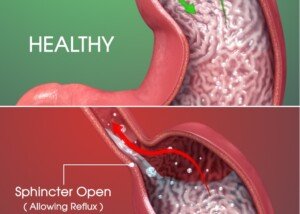
The term angina refers to chest pain brought on by a heart problem—specifically, ischemia or a shortage of oxygen due to restricted blood flow through the coronary arteries.
“Atypical angina” is a somewhat misleading term in that it implies that there’s something going on with the heart. And this terminology can cause worry.
However, atypical angina indeed refers to pain in the chest.
But pain in the chest doesn’t always mean that it’s related to the heart.
• Angina = chest pain coming from the heart due to compromised blood supply.
• Atypical angina = chest pain from non-cardiac issues and sometimes does not present like a classic case of ischemic angina.
Causes of Atypical Angina, aka Non-Cardiac Chest Pain
• Acid reflux, GERD or some other gastrointestinal issue.
• Costochondritis or another musculoskeletal issue.
• Respiratory issues
• Stress and anxiety
Atypical Angina Caused by GERD
“GERD is a disease where the esophagus is exposed to abnormal amounts of acid which is not designed to tolerate,” says Jay Desai, MD.
Dr. Desai specializes in colon cancer screening, upper endoscopy and consultative gastroenterology with New York Gastroenterology Associates.

Shutterstock/solar22
“The most common symptom is a burning sensation in the chest, which can also manifest as a tightening sensation,” adds Dr. Desai.
However, Dr. Desai points out that the sensation of tightening is just that: a sensation. The chest doesn’t actually tighten.
“In general, remember that just because a patient has the diagnosis of GERD, not all typical and atypical symptoms [of either angina or acid reflux] an individual experiences should be associated with or blamed on acid reflux unless they are diagnosed with an esophageal pH probe study,” says Hugh Mai, MD, a gastroenterology and internal medicine specialist in Baltimore, MD.
“Costo”
Costochondritis is nowhere near unheard of in the muscle building community and is often called “costo.”
Bodybuilders know what this means, and it can really hurt, making these athletes wonder if there’s a problem with their heart.
“Chest pain caused by costochondritis is a common mimic of cardiac chest pain,” says Donna P. Denier, MD, of The Cardiology Center with the Appalachian Regional Healthcare System in NC.
“It comes from the chest wall and usually involves the joints between the ribs and the sternum in the anterior chest.”
Dr. Denier adds that the pain of this form of atypical angina tends to be sharp and is worsened with movement, breathing or coughing.
Strained chest muscles from a hardcore chest routine at the gym can also cause some funky things going on with the musculature – leading to sensations of dull pain or aching.
A chest muscle spasm, which can also result from an intense workout, will get your attention.
Respiratory Atypical Angina
If you’re experiencing atypical angina (chest pain) due to pneumonia, chances are you’re also suffering from a nagging cough. You may not necessarily have a fever.
Atypical angina can also be caused by a blood clot in the lung called a pulmonary embolus which can kill within minutes.
Stress and Anxiety
Stress and excessive worry are leading causes of atypical angina. Panic attacks, too, often cause chest pain.
Key Differences Between Angina and Atypical Angina
In atypical angina, unlike ischemic angina, the discomfort is sometimes worsened or improved with movement or certain body positions.
These include lying down, overhead arm movements, stretching or twisting the trunk, inhaling or exhaling, coughing and sneezing.
Angina from blocked coronary arteries, on the other hand, does not change in pain level with any positional movement — unless there’s physical exertion involved. That’s very important to distinguish.
Stable anginal pain is trigged by physical exertion or high charged emotions and dissipates when the triggering agent ceases.
Unstable angina is a dangerous condition and can come on spontaneously, even during sleep and awaken the individual. It can mean an imminent heart attack.
Additional Differences
• Stable angina typically lasts at least a few minutes (e.g., triggered by walking up a flight of stairs).
• Atypical can last seconds to hours or all day.
• Unstable angina can actually last a few hours, as the heart with dangerously blocked arteries is struggling to get enough oxygen.
• Stable angina is predictable (with physical exertion, even light in severe cases, or with strong emotions, and subsides soon after the triggering event ends).
• Unstable angina is not predictable when it occurs at rest.
• Typical angina may present with tenderness or pain when one presses upon the chest area. This isn’t the case with a heart related problem.
So Let’s Get to the Bottom of This
Ultimately, the “angina vs. typical angina” topic comes down to terminology.
This can also be referred to as “cardiac chest pain vs. benign chest pain.”
“Atypical angina” is an uncommonly used term.
The more common terminology is “non-cardiac chest pain,” or, a reference to a more specific cause such as “chest pain from acid reflux.”

Board certified in internal medicine and gastroenterology, Dr. Desai provides a wide range of GI services including for bacterial overgrowth, constipation, acid reflux and GERD, IBS, incontinence and small bowel disease. Twitter handle: @NYGADocs

Dr. Denier has been practicing medicine for over 20 years and is board certified by the American Board of Internal Medicine – Cardiovascular Disease.
 Hugh Mai, MD, has 35+ years of experience and is well-versed in the endoscopic treatment of GERD. His areas of focus include interventional endoscopy, metabolic endoscopy and gut health.
Hugh Mai, MD, has 35+ years of experience and is well-versed in the endoscopic treatment of GERD. His areas of focus include interventional endoscopy, metabolic endoscopy and gut health.
 Lorra Garrick has been covering medical, fitness and cybersecurity topics for many years, having written thousands of articles for print magazines and websites, including as a ghostwriter. She’s also a former ACE-certified personal trainer.
Lorra Garrick has been covering medical, fitness and cybersecurity topics for many years, having written thousands of articles for print magazines and websites, including as a ghostwriter. She’s also a former ACE-certified personal trainer.
.








































